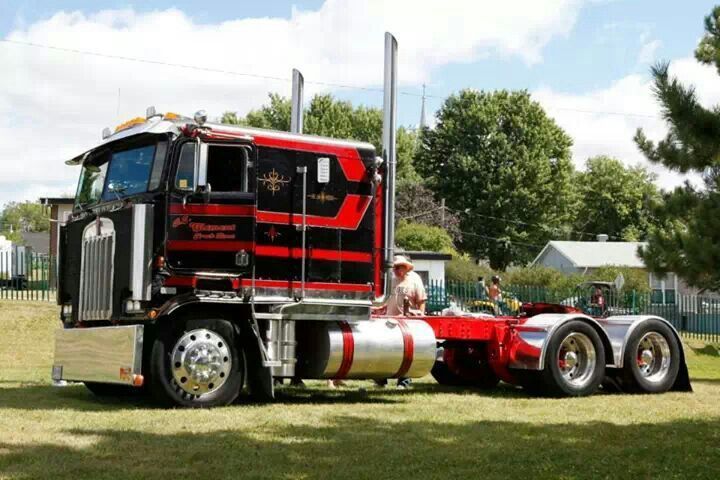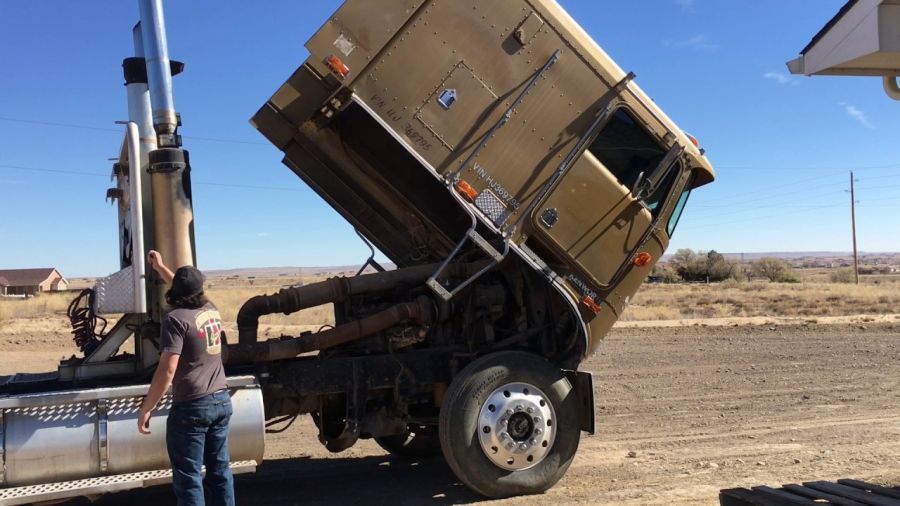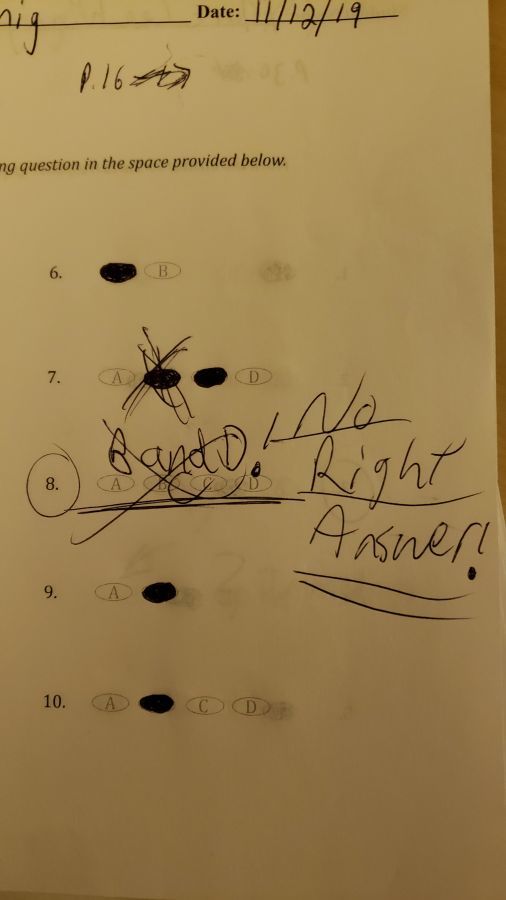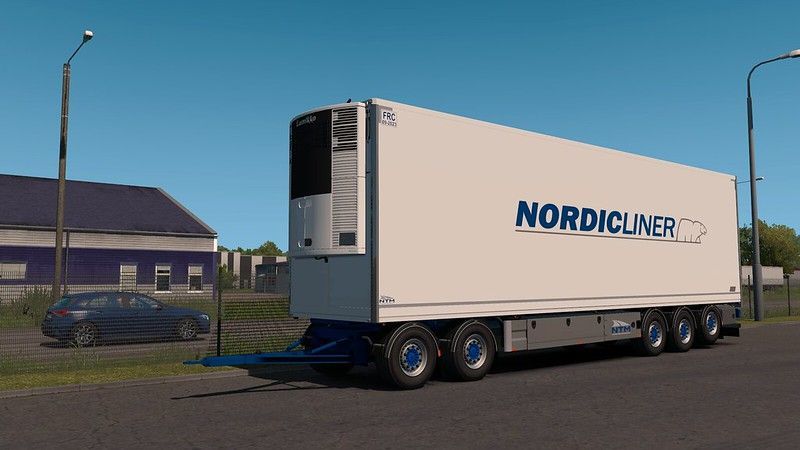Another Odd / Bad Test Question...
Topic 27042 | Page 2
What is a COE?
What is a COE?

Cab Over Engine (or simply Cab-Over). Old style.
We had these for yard trucks in school. You sit ON THE WHEEL (and engine) - doubt they'd be much fun OTR. Still the mainstay in much of Europe. There's some floating around here - a lot of them are lovingly restored and cared for...
Rick
OTR:
Over The Road
OTR driving normally means you'll be hauling freight to various customers throughout your company's hauling region. It often entails being gone from home for two to three weeks at a time.

Fun until you have to get to the motor, and all your stuff in the cab/sleeper wants to visit the front floorboards.
Rick
I consider the correct answer to be "C"
And you would be CORRECT!
Difference between a semi-trailer and a full trailer
Which is even MORE BIZARRE. A full trailer has wheels front and rear of the trailer - and is DRAGGED. But it's WEIGHT IS BORNE BY IT'S OWN AXLES.
Can't honestly say I've seen one of these. Another example, might be a double on a dolly.
Rick
BUT FOR THAT TO BE CORRECT ISN'T IT NO PART OF ITS WEIGHT RESTING ON THE TOW VEHICLE * NOT * TOWED VEHICLE ?!?
Pretty sure I know the difference between those two vehicles!
I gotta go with 
 once again!
once again!
HOS:
Hours Of Service
HOS refers to the logbook hours of service regulations.
Fun until you have to get to the motor, and all your stuff in the cab/sleeper wants to visit the front floorboards.
Rick
Not to mention a head on collision!

Old School explains:
I'll give a hint. A "full" trailer is not a reference to how much is in the trailer. A "full" trailer is a type of trailer, just as a "semi" trailer is a type of trailer.
Exactly like Rick says, these questions are designed to trip you up, and O. S. and I were too. But on my third or fourth reading, I realized the key phrase was that the vehicle in question was not the towed vehicle but the one doing the towing with no weight resting on the towed vehicle! So it's not a trailer of any kind but a power unit, or tractor.
Now on all the tests I've seen*, no question has no more than one correct answer. So either you'll never see this question, or the "D. Conventional tractor" is correct.
* I teach the CDL permit class and have seen almost all 300 questions used.
CDL:
Commercial Driver's License (CDL)
A CDL is required to drive any of the following vehicles:
- Any combination of vehicles with a gross combined weight rating (GCWR) of 26,001 or more pounds, providing the gross vehicle weight rating (GVWR) of the vehicle being towed is in excess of 10,000 pounds.
- Any single vehicle with a GVWR of 26,001 or more pounds, or any such vehicle towing another not in excess of 10,000 pounds.
- Any vehicle, regardless of size, designed to transport 16 or more persons, including the driver.
- Any vehicle required by federal regulations to be placarded while transporting hazardous materials.
OWI:
Operating While Intoxicated
Old School explains:
I'll give a hint. A "full" trailer is not a reference to how much is in the trailer. A "full" trailer is a type of trailer, just as a "semi" trailer is a type of trailer.
Exactly like Rick says, these questions are designed to trip you up, and O. S. and I were too. But on my third or fourth reading, I realized the key phrase was that the vehicle in question was not the towed vehicle but the one doing the towing with no weight resting on the towed vehicle! So it's not a trailer of any kind but a power unit, or tractor.
Now on all the tests I've seen*, no question has no more than one correct answer. So either you'll never see this question, or the "D. Conventional tractor" is correct.
* I teach the CDL permit class and have seen almost all 300 questions used.
Errol, if Conventional tractor is correct so is COE isn't it???
(This is a JJ Keller text classroom exam).
My submission:

CDL:
Commercial Driver's License (CDL)
A CDL is required to drive any of the following vehicles:
- Any combination of vehicles with a gross combined weight rating (GCWR) of 26,001 or more pounds, providing the gross vehicle weight rating (GVWR) of the vehicle being towed is in excess of 10,000 pounds.
- Any single vehicle with a GVWR of 26,001 or more pounds, or any such vehicle towing another not in excess of 10,000 pounds.
- Any vehicle, regardless of size, designed to transport 16 or more persons, including the driver.
- Any vehicle required by federal regulations to be placarded while transporting hazardous materials.
BMI:
Body mass index (BMI)
BMI is a formula that uses weight and height to estimate body fat. For most people, BMI provides a reasonable estimate of body fat. The BMI's biggest weakness is that it doesn't consider individual factors such as bone or muscle mass. BMI may:
- Underestimate body fat for older adults or other people with low muscle mass
- Overestimate body fat for people who are very muscular and physically fit
It's quite common, especially for men, to fall into the "overweight" category if you happen to be stronger than average. If you're pretty strong but in good shape then pay no attention.
OWI:
Operating While Intoxicated
Old School explains:
I'll give a hint. A "full" trailer is not a reference to how much is in the trailer. A "full" trailer is a type of trailer, just as a "semi" trailer is a type of trailer.
Exactly like Rick says, these questions are designed to trip you up, and O. S. and I were too. But on my third or fourth reading, I realized the key phrase was that the vehicle in question was not the towed vehicle but the one doing the towing with no weight resting on the towed vehicle! So it's not a trailer of any kind but a power unit, or tractor.
Now on all the tests I've seen*, no question has no more than one correct answer. So either you'll never see this question, or the "D. Conventional tractor" is correct.
* I teach the CDL permit class and have seen almost all 300 questions used.
The the "towed vehicle" part tripped me up too (and here I was advising to READ THE QUESTION CAREFULLY). I only saw TOW VEHICLE - not TOWED
But if CONVENTIONAL TRACTOR is correct, than so would COE - as they are both tractors -the only difference being: one has a cab over the engine that tilts up, and the other has a "regular hood" with a fixed cab. Otherwise - neither one has any of ITS WEIGHT RESTING ON THE TOWED VEHICLE.
I'm thinking typo, or more than one correct answer (which on multiple guess tests - the answer would be "both B, & D", since both are "supported by their OWN AXLES", and "do not rest weight on THE TOWED VEHICLE" (being that both full & semi trailers ARE THE TOWED VEHICLE).
If you took the time to read this on a REAL DMV TEST - and started scratching your head - and the choice SKIP QUESTION was available.
Most folks would answer "full trailer" (assuming they ACTUALLY KNEW what one was), ignoring the fact the question appears to refer SPECIFICALLY TO the vehicle that was DOING THE TOWING - which would make B&D correct.
So we have to wait for what MARK REPORTS THE INSTRUCTOR SAYS - which isn't necessarily going to be correct either...
Rick
CDL:
Commercial Driver's License (CDL)
A CDL is required to drive any of the following vehicles:
- Any combination of vehicles with a gross combined weight rating (GCWR) of 26,001 or more pounds, providing the gross vehicle weight rating (GVWR) of the vehicle being towed is in excess of 10,000 pounds.
- Any single vehicle with a GVWR of 26,001 or more pounds, or any such vehicle towing another not in excess of 10,000 pounds.
- Any vehicle, regardless of size, designed to transport 16 or more persons, including the driver.
- Any vehicle required by federal regulations to be placarded while transporting hazardous materials.
Dm:
Dispatcher, Fleet Manager, Driver Manager
The primary person a driver communicates with at his/her company. A dispatcher can play many roles, depending on the company's structure. Dispatchers may assign freight, file requests for home time, relay messages between the driver and management, inform customer service of any delays, change appointment times, and report information to the load planners.DMV:
Department of Motor Vehicles, Bureau of Motor Vehicles
The state agency that handles everything related to your driver's licences, including testing, issuance, transfers, and revocation.
OWI:
Operating While Intoxicated
Marc Lee wonders:
Errol, if Conventional tractor is correct so is COE isn't it???
This is true. And at any Iron Skillet, the truckers would be talking about "conventional" and "cab over" the same as anyone referring to a "two door" or a "four door" car.
And why Rick settled on either "typo" or "both 'B' and 'D'" answers.
What we have here is a unicorn. We're looking at it but in reality it doesn't exist.

New Reply:
New! Check out our help videos for a better understanding of our forum features

















Preview:
This topic has the following tags:
CDL Exam CDL Test Preparation Getting Your CDL








 TT On Facebook
TT On Facebook
That's what I meant - designed to SCREW YOU UP.
Again - I think it's an "unusual question" - because short of farm trailers (think bales of hay) - you won't see this type of trailer on the highway in the US often (if at all).
Rick
OWI:
Operating While Intoxicated